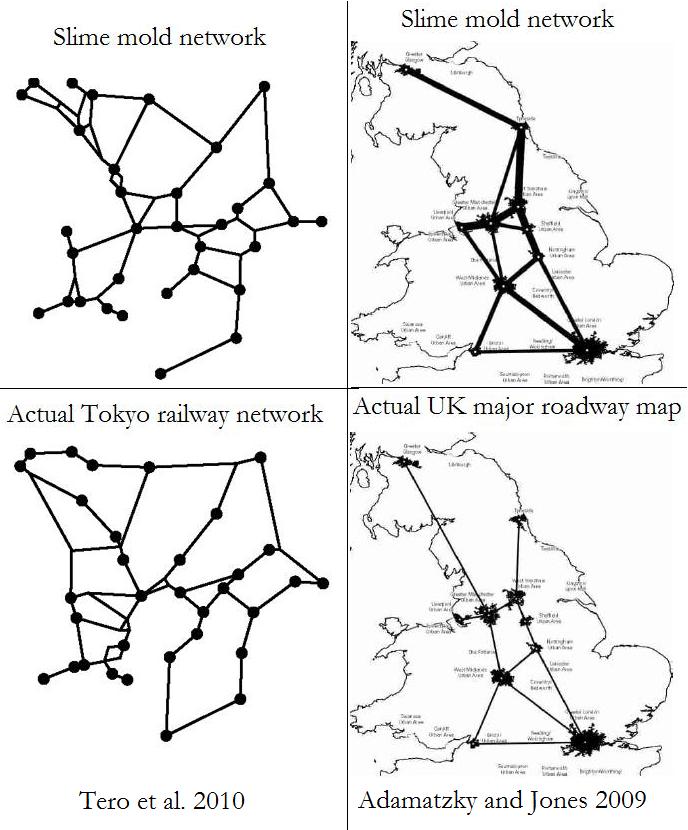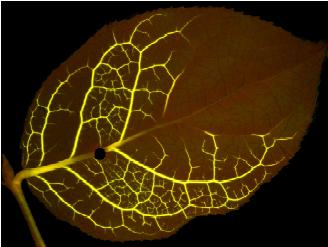Posts Tagged ‘urban planning’
Nature-inspired network design: recent studies in slime mold and leaf veins
![]() Nature-inspired design: this phrase makes me think of shark-skin swimsuits, velcro, and an endless assortment of coffee tables using natural knots and tree branches. There is logic behind design reliant upon natural elements. After all, organisms have been undergoing evolution for millions of years for the sake of efficiency. If anyone knows how to cut through the water cleanly, it would be a shark, wouldn’t it?
Nature-inspired design: this phrase makes me think of shark-skin swimsuits, velcro, and an endless assortment of coffee tables using natural knots and tree branches. There is logic behind design reliant upon natural elements. After all, organisms have been undergoing evolution for millions of years for the sake of efficiency. If anyone knows how to cut through the water cleanly, it would be a shark, wouldn’t it?
When thinking about designing human networks, it thus seems “natural” to turn to nature, which certainly has expertise in the subject. Every organism has to have a way of transporting nutrients and water around its body, systems which become more complicated as the organisms do. Think about your circulatory system: all those veins and arteries and capillaries seemingly spread through your skin and innards at random. But this network of transport tubes has gone through great evolution in order to be so intricate that it seems random to us.
Three recent papers have highlighted the use of organisms to help plan civilized networks: that is, highways and train systems. The first two papers feature one of my father’s favorite organisms, the slime mold, while the third looks at leaf vein systems. (For my post on leaf veins as drivers of plant evolution, click here.)
Slime molds are plasmodial protists — their cellular structure is undefinable. While a slime mold can live as a unicellular and uninuclear organism, if it runs into another of its own species, the two will join by their cellular membranes. If there are many around, the organism can potentially become a huge amorphous sac with many nuclei, spreading over a surface foraging for food. (The question is: is it the singular cell membrane or the singular nucleus that makes an organism “unicellular?”) Here’s a quick video by John Bonner, a Princeton slime mold specialist, showing the beauty of this unfortunately-named creature:
Edit: A commenter pointed out that John Bonner’s “slime molds” are different than the ones used in the research discussed below. The slime molds in this video, Dictyostelium discoideum, do in fact form a multicellular organism and don’t exhibit the same sort of networking behavior. The video is still worth watching, but be aware of these differences! (Thanks, Iain and class!)
When foraging, the blob spreads over a surface looking for sugar. Once food is located, it will redirect most of its mass elsewhere, leaving a vein behind leading to the food source. After millions of years of evolution, one would expect that this vein would be the most efficient path between the two points.
Independently, two groups of researchers took advantage of this assumption to use slime mold to compare its foraging network between food sources to our networks connecting cities. (For the record: one of the papers was published in the International Journal of Bifurcation and Chaos, which is an obsession-worthy title.) Each team laid out oat flakes simulating the layout of major cities (one oat flake each!) in their region of choice – the UK and Tokyo metro areas. The question: will the slime mold trails emulate our own systems, thought out by our grand human brains for efficiency?

Slime mold networks compared to actual city planning. Image maniputed; see papers for original figures
The answer: for the most part, yes! As you can see in the above figures, the authors of each paper saw very similar networks to our own. However, the slime mold lacked a more circular structure, connecting the outer hotspots to one another. And why would it have these: due to its impermanent nature, a slime mold does not need the forethought to create multiple connections to the same spot. If one is broken, they can simply create a new line leading straight through.
 If we’re trying to use these organisms to help us plan transportation networks, obviously this is not a perfect fit, as weather and technical problems cause blocked lines frequently. We do need this sort of forethought when laying out our cities! But we are not the only ones. A paper published last week in Physical Review Letters (open access here) looked at branching patterns in leaf venation.
If we’re trying to use these organisms to help us plan transportation networks, obviously this is not a perfect fit, as weather and technical problems cause blocked lines frequently. We do need this sort of forethought when laying out our cities! But we are not the only ones. A paper published last week in Physical Review Letters (open access here) looked at branching patterns in leaf venation.
Just like in our own circulatory system, the network of veins bringing nutrients and water throughout a leaf cannot be simply retracted and reformed, but is a permanent structure. With herbivores knawing holes all the time, you betcha that plants have evolved “looping networks,” as the authors put it, to ensure that a blockage in one pathway doesn’t deprive the entire leaf of nutrients. Traditionally modelling has shown these looping networks to be inefficient compared to non-circular, tree-like networks. Do you think these authors believed that?
As support for their premise, they punched a hole through the central vein of a lemon leaf (see image above) and injected fluorescent dye below. And behold! The dye was able to spread throughout the leaf despite this disruption. They then created a model that incorporated the network’s (a) resilience to damage and (b) variation in load. Separately and together, the models agreed: looping networks are actually more efficient in the long run.
What do these studies put together show us? That neither alone is good enough. We need our slime-mold, treelike networks for basic structure, with some excess leaf-vein looping for support during damage control and tourist influx. (You never know when you’ll host the Olympics.) The circularity might seem excessive, but when bad times hit, it will be worth it. (The citizens will appreciate it too.)
This may seem like second nature to many of you. But sometimes it’s nice to get some support from “first nature,” amiright?
(Endnote: I really am curious about the grammar for slime mold. Are slime mold(s) awesome or is a slime mold awesome? Guesses/answers in the comments, if you are so inclined.)
Andrew Adamatzky, & Jeff Jones (2009). Road planning with slime mould: If Physarum built motorways it would
route M6/M74 through Newcastle International Journal of Bifurcation and Chaos arXiv: 0912.3967v1
Katifori, E., Szöllősi, G., & Magnasco, M. (2010). Damage and Fluctuations Induce Loops in Optimal Transport Networks Physical Review Letters, 104 (4) DOI: 10.1103/PhysRevLett.104.048704
Tero A, Takagi S, Saigusa T, Ito K, Bebber DP, Fricker MD, Yumiki K, Kobayashi R, & Nakagaki T (2010). Rules for biologically inspired adaptive network design. Science (New York, N.Y.), 327 (5964), 439-42 PMID: 20093467





